How to Rank Higher on Google in 2025: The Ultimate Guide
Want to be at the top of Google? You're not alone. Any business, blog, or content creator would want their content on the first page of Google. With constantly evolving algorithm updates, shifting search behaviors, and stiff competition, being on top of Google is however a science and an art.
In this approachable, hands-on, and fact-packed guide, we'll take you through the proven steps to boost your rankings—while remembering the newest EEAT (Experience, Expertise, Authoritativeness, and Trustworthiness) principles.
Let's simplify SEO and get you climbing Google's rankings—step by step guide on how to rank higher on Google.
How to Rank Higher on Google: Step by Step Guide
1. Learn About Google's Mission
Google's mission is simple: deliver the most useful, relevant, and authoritative results to users. If your content best serves real user needs, you're likely to rank well.
In 2025, Google continues to prioritize content that is relevant to:
Search intent
User experience (UX)
Mobile and page speed optimization
Trustworthiness and expertise (EEAT)
2. Prioritize Search Intent First
The SEO golden rule: Match your content with the intent of the user.
There are four broad search intent categories:
Informational (e.g., "how to rank higher on Google")
Navigational (e.g., "Google Search Console")
Transactional (e.g., "buy SEO tools online")
Commercial Investigation (e.g., "best SEO plugins for WordPress")
Your post won't rank if it doesn't directly meet the user's purpose in searching—no matter how nicely written it may be.
Tip: Use Google's own search results to see what type of content is ranking for your keyword. That tells you about the search intent.
3. Create High-Quality, Human-Centered Content
High-quality content continues to reign supreme in SEO in 2025.
But what does that look like?
Characteristics of High-Quality Content:
Helpful and actionable: Offer actual solutions.
Original and unique: No fluff or duplicated content.
Engaging: Use storytelling, personal experience, and real-world examples.
Well-formatted: Employ headings, bullet points, bold keywords such as how to rank higher on Google, and brief paragraphs.
Updated: Mirror the current practices (such as this article does).
Pro Tip: Google's "Helpful Content Update" prefers content written for humans—not search engines. Always write for humans first, optimize for search second.
4. Optimize for EEAT: Google's Key Ranking Factor
In 2025, EEAT is more applicable than ever. Here's how to build each pillar:
1. Experience
Speak from real experience. Share case studies, results, tests, or personal findings. Google now takes "experience" into account based on content tone and author credentials.
2. Expertise
Include author bios. Back up your claims with data, solid links, or certifications. Show you are an expert.
3. Authoritativeness
Get linked to or mentioned by other authoritative websites. Guest blog, partner, and build your brand.
4. Trustworthiness
Use HTTPS, list contact details, have a privacy policy, and ensure your site looks clean and secure.
If you’re writing about how to rank higher on Google, make sure your article sounds like it’s written by someone who has actually done it.
5. Do Proper Keyword Research (Not Just Guessing)
Keyword research isn’t dead—it’s just more sophisticated now.
Here’s how to do it right in 2025:
Use tools like Ahrefs, Semrush, or Ubersuggest.
Target long-tail keywords like how to rank higher on Google for free or how to increase Google rankings in 2025.
Check keyword difficulty and search volume.
Prioritize low competition, high intent keywords.
Keyword Tip: Include your primary keyword (how to rank higher on Google) 0.8%–1.5% of the total word count for optimal SEO density.
6. On-Page SEO: Make Every Page Count
Here's your must-have on-page checklist:
- Create high-quality, useful, and human-centered content
- Use the keyword how to rank higher on Google organically and strategically
- Comply with Google's EEAT requirements: Experience, Expertise, Authoritativeness, and Trustworthiness
- Perform mobile-friendliness tweaks and become Core Web Vitals compliant
- Obtain high-quality, relevant-to-niche backlinks
- Leverage Google Search Console and Google Analytics to track and improve performance
- Refresh and renew outdated content periodically to stay current
- Develop structured topic clusters with related supporting content
- Amplify your brand presence on sites
- Encourage user interaction (comments, shares, repeat visits)
- Increase CTR and reduce bounce rate with good titles and engaging content
7. Mobile & Core Web Vitals Optimization
Google is mobile-first. If your site is not responsive on mobile, then goodbye to the top ranks.
Better:
Page speed (use PageSpeed Insights or GTmetrix)
Mobile responsiveness
Visual stability (no layout shifts)
Load under 2 seconds
Use lazy loading, image compression, and clean code.
8. Get Quality Backlinks (Still a Top 3 Factor)
Backlinks = confidence votes.
But not all backlinks are equal. In 2025, one from a high authority website is more powerful than 100 random ones.
Proven Link-Building Methods:
Guest blogging
Skyscraper strategy
Podcasting and interviewing
HARO (Help a Reporter Out)
Linkable assets like infographics or studies
Pro Tip: Keep it topical. Writing about ranking better in Google, SEO blog link backs are more valuable than whole sites.
9. Use AI, But Not Only Rely on It
AI can be used to aid SEO tasks like keyword research, content organization, and summarizing—but Google is able to spot generic AI-written content.
Edit, review, and include your own commentary every time. Never use AI exclusively as a substitute for your ability.
10. Use Google Search Console and Analytics
Don't fly blind. Use Google Search Console to:
Submit sitemap
Monitor search performance
Fix crawling issues
See which pages rank and why
Google Analytics allows you to track behavior: bounce rate, time on site, page views—all worth knowing for SEO.
11. Renew Outdated Content
Google prefers new, fresh content.
Steps to renew:
Revamp outdated stats or screenshots
Add new sections
Fix broken links
Improve readability
Re-optimize for long-tail keywords
Minor changes can make a big impact if the content is already indexed.
12. Have a Solid Brand Presence
Google prefers brands.
How to build yours:
Be active on social media
Get referenced in forums and directories
List your business in Google My Business
Incorporate customer reviews
Consistent name, address, phone number (NAP) everywhere
If people search your brand name + topic (e.g., “RightBookmarking how to rank higher on Google”), you’re winning.
Alongside optimizing for Google, businesses are increasingly leveraging social media to generate leads and build brand presence. Learn how in this comprehensive SMMA guide by RightBookmarking.
13. Encourage Engagement (and Reduce Bounce Rate)
Google looks at how users interact with your site.
Improve:
Time on site by embedding videos or longer content
Click-through-rate (CTR) with compelling meta titles
Lower bounce rates using engaging intros and clear next steps
Encourage shares, return visits, and comments.
14. Build Supporting Content Clusters
One. Good.
Ten. Related ones? Much, much better.
Topic. Clusters help Google understand your content structure.
Example Cluster:
Main Topic: How to rank higher on Google
Sub-topic. Best SEO tools for beginners
Sub-topic: What is keyword density?
Sub-topic: How to get backlinks in 2025.
Best. Sub-topic: Technical SEO checklist
Link all. Related articles with anchor text.
Final Thoughts:
To place yourself above Google, you need to optimize both what humans love and algorithms demand. Put useful, experience-spattered content first, build authority, technically optimize, and never stop testing for how to rank higher on Google.
No shortcuts. No hacks. Only smart, strategic SEO w

.jpg)


